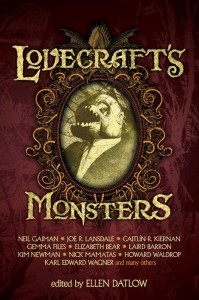Edited by Ellen Datlow
Tachyon, March 2014
Trade paperback, 380pp., $16.95; eBook, $9.99
Reviewed by Michael R. Collings
Having learned through pleasurable experience over the years that the phrase “Edited by Ellen Datlow” serves as an almost gold-plated guarantee of quality, I looked forward with great eagerness to receiving a copy of her latest anthology, Lovecraft’s Monsters. When it arrived, the first thing I noted was its thickness: “Ahhh, hundreds of pages of creepiness and horror!” The second thing was the cover: a highly evocative, oval portrait frame (how appropriate), surrounded by what might be quotidian furbelows but that, on closer inspection, prove to be coiling and roiling tentacles. And inside the frame, a representation of…something Lovecraftian.
All told, an excellent introduction to what waited inside.
Datlow has collected eighteen of the best examples of Lovecraft’s cosmic vision, peopled by his favorite aberrations and abominations. The list of authors includes Neil Gaman, Laird Barron, Kim Newman, Thomas Ligotti, Howard Waldrop and Steven Utley, Steve Rasnic Tem, Karl Edward Wagner, and the inimitable Joe R. Lansdale, with an extra-long capstone story by John Langan. Rounding out the volume is a short but useful index to the monsters themselves, consisting of a quotation from Lovecraft featuring the creature in question; a brief definition and—where possible—a description; a reference to its first appearance in print; and a list of the stories in the anthology that deal with it. Simply as a quasi-encyclopedia of things Lovecraftian, the book is excellent.
When one gets to the stories themselves, it only gets better.
Gaiman’s “Only the End of the World Again” plays on several horror motifs, concentrating on one central to so many of Lovecraft’s stories—the incipient ending of all things and the resurgence of some sort of cosmic creatures, here the “Deep Ones.” The setting is Innsmouth, which alerts readers as to what to expect. The hero sounds suspiciously like a werewolf, awakening in the first paragraphs in bed, naked, surrounded by coarse animal hairs. When, a few pages in, he notes that the sign on his temporary office on Marsh Street reads “Lawrence Talbot: Adjustor,” the underlying concatenation of horrors becomes apparent. What follows is logical, perfectly atmospheric, and only partially comic.
Brian Hodge’s “The Same Deep Waters as You” again deals with Innsmouth…this time with the dwindling number of survivors from the original 1928 federal raid. Kerry Larimer has an almost mystical bonding with animals, so much so that she has her own television show, The Animal Whisperer. Now she has been effectively commandeered by Homeland Security to use her talents to understand why the survivors—prisoners for nearly a century on an isolated island—are suddenly behaving most peculiarly. She does…and in doing so loses everything she holds dear.
Visiting Innsmouth yet again, Kim Newman’s short piece “A Quarter to Three” provides a slice-of-life view of the town in the depths of night. The setting is Cap’n Cod’s 24 Hour Diner; the characters a time-worn waitress and a pregnant girl waiting for the father of her child. Eventually he—or should that be it—arrives.
Howard Waldrop and Steven Utley combine their estimable talents in “Black as the Pit, from Pole to Pole.” Beginning with a literary allusion as title, the story compounds the strength of borrowing as it blends things Lovecraftian with the nineteenth-century search for an entry into a hollow earth constructed of concentric circles, each sustaining its own strange form of life. What makes the story truly remarkable is its hero: Frankenstein’s monster, picking up where Shelley’s novel concluded and making its own foray into unspeakable lands peopled with unspeakable monsters. The blend of several mythic threads works well, creating one of the more powerful stories in the collection.
Steve Rasnic Tem’s atmospheric “Waiting at the Crossroads Motel” is another play on the End of the World, as Walker, and eventually a crowd of others like him, stop at an otherwise insignificant motel in the middle of nowhere and…wait…as they slip farther and farther from being human.
In Karl Edward Wagner’s “I’ve Come to Talk with You Again,” readers gain insight into one way the cryptic King in Yellow sustains and maintains his faithful followers.
Joe Lansdale’s “The Bleeding Shadow” gives Lovecraft an east-Texas turn in tone and diction as the main character struggles to save Alma May’s no-account brother Tootie from an incursion from other dimensions. This time, music provides the key to calling and to repelling the unnamable—and either way, the ultimate cost is the musician’s soul.
Finally, John Langan’s “Children of the Fang” explores identity, reality, and sanity in a long tale of generations twisted and destroyed by an archaeologist’s long-kept secret. Multiple story-lines unfold gradually, and with each revelation, characters are challenged to accept the unbelievable.
There are other stories just as remarkable as these—these few are simply among my favorites. And, as with any anthology of this length, there are several that just didn’t speak to me for one reason or another. But taken as a whole, Lovecraft’s Monsters is a fitting tribute to a master who created a cosmos larger that his own imagination and invited others to share it. The selection covers a range of horrors, some merely touched upon and others investigated in page after page of powerful prose. Anyone interested in Lovecraft and his various mythoi will find much to enjoy, much to think about, and much to open dreams and nightmares.









